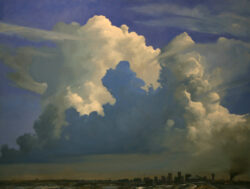Billy Solitario
Landscape painter Billy Solitario prefers to capture the natural world by painting en plein air, or painting in nature, a style popular among the Impressionists of the late nineteenth and early twentieth centuries.

Courtesy of Billy Solitario
Clouds Over New Orleans Skyline. Solitario, Billy (artist)
Billy Solitario finds beauty among the sand dunes, coastal savannahs, and barrier islands along the Louisiana and Mississippi Gulf Coast, much like the famed Mississippi painter Walter Anderson of two generations earlier. Solitario was born March 19, 1972, in Manhattan Beach, California, where his father worked on the Apollo space program. While he was still a child, the family moved to Gautier, Mississippi, near Ocean Springs (Walter Anderson’s hometown). There he spent his childhood enjoying the sea, beaches, open skies, and all that the Gulf Coast had to offer a young boy.
After graduating in 1994 from the University of South Florida in Tampa with a bachelor of arts degree, Solitario moved to New Orleans and worked a brief time for an advertising firm. From 1995 to 1998, he studied painting with Auseklis Ozols and Phil Sandusky at the New Orleans Academy of Fine Art. He joined their ranks in 2005, teaching landscape and portrait painting at the Academy. In 2003, Solitario received a master of fine arts degree from Tulane University in New Orleans, where he taught beginner’s drawing and painting from 2001 to 2003.
Solitario cites many artists as inspirations, including Walter Anderson, John Singer Sargent, and Diego Velázquez for their painting skills; and Edward Hopper for design.
Though Solitario explores various subjects in his paintings, including portraits and still lifes, he prefers landscapes. “People expect landscapes from me and a certain style,” he said. “I paint landscapes not because it sells but because it is what I paint. It’s that primal human instinct of wanting to be in nature. Plus, it’s an excuse to go into nature. What better job is there than to go camping and work while you’re out there.” While his images of the land are striking, his cloudscapes are even more dramatic. Dramatic skies dominate paintings such as Storm Clouds, Clouds Over Horn Island, and Clouds Over New Orleans.
As is true of many artists in the Gulf South, Hurricane Katrina and its destruction found their way not only into his life but his paintings. Works such as Searching the Debris, Breaching the Natural Levees, Wheelbarrow Under Clouds, and The Hurricane Proof House depict the terrible force of the storm’s winds and tidal surge, which destroyed Solitario’s studio in New Orleans and his parents’ house in Gautier, Mississippi.
In capturing the natural world, Solitario prefers to paint en plein air, a style popular among the impressionists of the late nineteenth and early twentieth centuries. “It’s fantastic,” he said of painting outdoors. “A photograph is a cropped piece of info flattened out. Plein air is three dimensional and you can move things around easier.” Solitario does use photography, however, as a convenient tool to record dramatic cloud formations as models for later use back in the studio. He also executes quick on-site studies and drawings to capture certain moods, lighting, and objects that will eventually be incorporated into paintings.
Solitario has received various awards and honors during his short career. In 2004, he was named a landscape finalist in the Twenty-first Annual Artist’s Magazine art competition. Other honors include being named in the top one hundred finalists in 2001 for the Wyoming-based National Park Academy of the Arts’ Arts for the Parks National Exhibition of Landscapes; the Emerging Artist Award of 1998 at the George Ohr Fall Show in Biloxi, Misissippi; the Gwendolyn Ozols Scholarship Award at the New Orleans Academy of Fine Arts in 1997; and best of show recognitions at the Singing River Art Association in 1997 in Pascagoula, Mississippi, and the Ocean Springs Art Show in both 1996 and 1999.
Solitario’s paintings are included in the collections of several New Orleans and Mississippi Gulf Coast museums and corporations, including several sites in New Orleans: the Ogden Museum of Southern Art, the Roosevelt Hotel, Whitney National Bank, the New Orleans Academy of Fine Arts, Northrup Grumman, and the Astor Crown Plaza Hotel.
